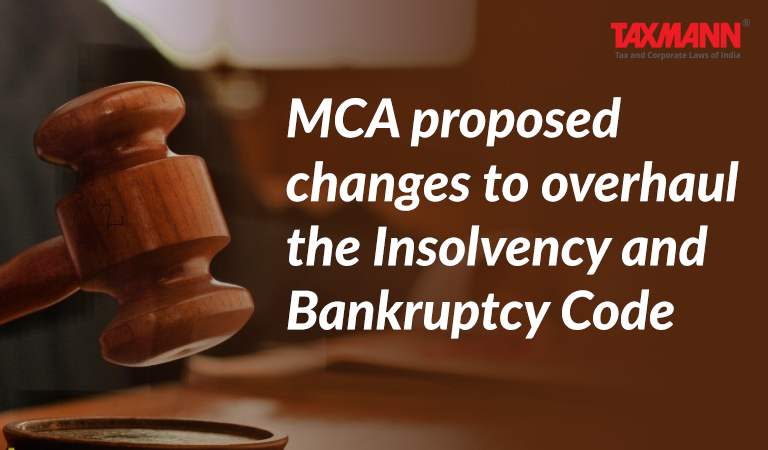MCA proposed changes to overhaul the Insolvency and Bankruptcy Code
- Blog|News|Insolvency and Bankruptcy Code|
- 2 Min Read
- By Taxmann
- |
- Last Updated on 20 January, 2023

Introduction
The Ministry of Corporate Affairs (MCA) has recently released a consultation paper outlining proposed changes to the Insolvency and Bankruptcy Code, 2016. The purpose of these changes is to improve transparency, reduce delays, and ensure efficient decision-making in insolvency proceedings.
The proposals aim to address various issues faced by stakeholders, including creditors, debtors, and insolvency professionals, in the current system. Overall, the MCA’s proposed changes aim to create a more efficient and effective insolvency framework for all stakeholders involved. The key highlights of the proposed changes are as follows:
1. Introduction of an E-platform in Insolvency Proceedings to streamline the insolvency process
The MCA has considered that the introduction of an e-platform for insolvency proceedings may provide for a better case management system, automated processes to file applications with the Adjudication Authorities (AAs), delivery of notices, enabling interaction of Insolvency Professionals (IPs) with stakeholders, etc.
The e-platform will provide regulators and Adjudicating Authorities with better oversight by consolidating information and making it easily accessible.
2. More reliance on data with Information Utilities (IUs) while considering applications
Presently, section 7 and 9 of the code provides that in addition to the record of default available with the IUs, other evidence can also be furnished to establish that a default has occurred. Now, it has been proposed that the code may be amended to only allow the Adjudicating Authority to use the record of default from the Information Utilities when evaluating applications under sections 7 and 9 of the Code.
3. An application filed under section 7 ‘must’ be admitted if default is established
Section 7 of the Code provides for an application by a financial creditor for the commencement of the CIRP in respect of a Corporate Debtor (CD). The Supreme Court has interpreted the use of ‘may’ in section 7(5) to indicate that the AA has the discretion to admit or reject despite existence of a default.
Now, it has been proposed that application filed under section 7 ‘must’ be admitted if default is established, the AA is only required to be satisfied about the occurrence of a default and fulfilment of procedural requirements for this specific purpose (and nothing more). Where a default is established, it is mandatory for the AA to admit the application and initiate the CIRP.
4. Clarification on the applicability of 14 days given u/s 7
The timeline of 14 days provided in section 7 has also been interpreted to apply only for ascertainment of default. However, it is also intended to apply to the AA’s decision to admit or reject the application under section 7(5).
Accordingly, it is proposed that a suitable amendment may be made to clarify the applicability of the timeline.
Click Here To Read The Full Article
Disclaimer: The content/information published on the website is only for general information of the user and shall not be construed as legal advice. While the Taxmann has exercised reasonable efforts to ensure the veracity of information/content published, Taxmann shall be under no liability in any manner whatsoever for incorrect information, if any.

Taxmann Publications has a dedicated in-house Research & Editorial Team. This team consists of a team of Chartered Accountants, Company Secretaries, and Lawyers. This team works under the guidance and supervision of editor-in-chief Mr Rakesh Bhargava.
The Research and Editorial Team is responsible for developing reliable and accurate content for the readers. The team follows the six-sigma approach to achieve the benchmark of zero error in its publications and research platforms. The team ensures that the following publication guidelines are thoroughly followed while developing the content:
- The statutory material is obtained only from the authorized and reliable sources
- All the latest developments in the judicial and legislative fields are covered
- Prepare the analytical write-ups on current, controversial, and important issues to help the readers to understand the concept and its implications
- Every content published by Taxmann is complete, accurate and lucid
- All evidence-based statements are supported with proper reference to Section, Circular No., Notification No. or citations
- The golden rules of grammar, style and consistency are thoroughly followed
- Font and size that’s easy to read and remain consistent across all imprint and digital publications are applied





